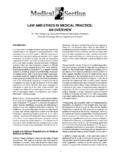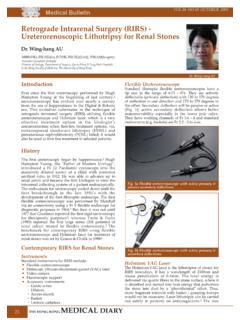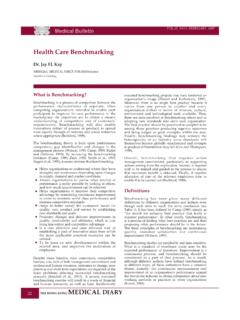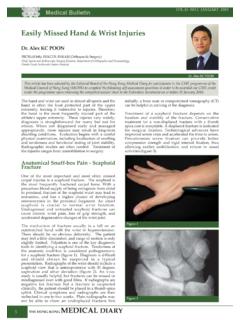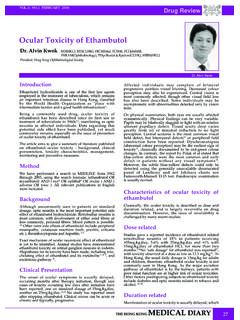Transcription of New Childhood Immunisation Programme in Hong Kong
1 JULY 2007 IntroductionIn Feb 2006, the Department of Health in hong Kongstarted to implement a new universal immunisationprogramme for children. The old and new immunisationschedules are shown in Table 1. In the new Programme ,oral polio vaccine (OPV) is replaced by inactivated poliovaccine (IPV) and whole cell pertussis vaccine (wP) isreplaced by acellular pertussis vaccine (aP). In addition,vaccines against diphtheria, tetanus, pertussis andpoliovirus are given as a combined quadruple vaccine(DTaP-IPV) instead of separate DTaP and IPV this article we shall review the rationale behind andevidence supporting the change in the immunisationprogramme.
2 We shall also briefly review othercombination vaccines widely used in private sector inHong Kong, as well as the differences between our localchildhood Immunisation Programme and that of theUnited States and the United vs OPVThe Salk formalin-inactivated polio vaccine and theSabin live-attenuated oral polio vaccine were licensed inthe US in 1955 and 1961 respectively. Thoughdeveloped later, OPV soon replaced IPV in mostcountries as it is inexpensive, requires no needle,produces mucosal immunity and herd immunity. Morethan 95% of recipients develop long-lasting immunityto all 3 types of poliovirus after 3 doses of OPV.
3 On theother hand, the immunogenicity of the original IPV waslow and was replaced in 1988 by enhanced-potency IPVwhich has greater antigenic content. Both IPV and OPVinduce mucosal immunity of the gastrointestinal tract,but that induced by OPV is superior,1thoughpharyngeal mucosal immunity is comparable for bothvaccines. Herd immunity induced by the spread of thelive polioviruses of OPV offers distinct advantage andcontributes to the global eradication of and mass administration of OPV in the past 40years has markedly reduced the incidence of paralyticpoliomyelitis in most parts of the world as well as inHong Kong; and OPV is still the type of polio vaccinerecommended by WHO for eradication of polio inendemic countries.
4 Although the public health benefitof OPV is enormous, there is a trend in the switch ofOPV to IPV in many developed countries because OPVis associated with a severe adverse effect, namelyvaccine-associated paralytic poliomyelitis (VAPP),which occurs in approximately 1 per million OPVdoses in England2and 1 per million doses in theUS3 Apart from VAPP, vaccine-derived poliovirus canbe excreted in faeces and cause outbreaks eradication of poliomyelitis in the US since 1979,the risk for VAPP is considered to outweigh its , in 1997, the US Advisory Committee onImmunization Practices (ACIP) recommended replacingthe all-OPV schedule with a sequential schedule of IPVfollowed by OPV to decrease the risk for VAPP whilemaintaining the benefits of OPV.
5 This sequentialschedule was accepted with no decline in immunisationcoverage despite the need for additional injections. In2000, ACIP went on to recommend exclusive use of IPVto eliminate the risk of VAPP. However, ACIP reaffirmsOPV as the only vaccine recommended to eradicatepolio from endemic countries. Based on similarcircumstances and rationale, hong Kong has nowswitched to IPV for universal Childhood have confirmed that 99%-100% of childrendevelop protective antibodies after administration response is not inferior toOPV in a randomised controlled addition,more than 90% of vaccinated persons have serumantibodies 25 years after the fourth is no direct evidence that IPV is equally effectiveas OPV in preventing outbreaks of poliomyelitis.
6 Switching from OPV to IPV is considered unlikely toresult in resurgence of poliomyelitis given the currenteradication of polio in our locality. Furthermore, anextensive review has not found any serious adverseevent caused by , switching from OPVto IPV in hong Kong is likely to have a good risk-benefit ratio, and experience from the US has shownthat vaccine uptake is unlikely to be compromised bythe vs Whole cell pertussisvaccineVaccines made from killed whole Bordetella pertussisorganisms have been available since the , whole cell pertussis vaccines have manyadverse effects which include reactions such as fever,irritability and injection site pain commonly.
7 Andtransient severe reactions such as hypotonic-hyporesponsive episodes, convulsions and acuteencephalopathy rarely. Acellular pertussis vaccinescontaining purified or recombinant Bordetella pertussisantigens instead of intact organisms have beenNew Childhood Immunisation Programmein hong KongDr. Daniel KL CheukDepartment of Paediatrics and Adolescent Medicine, The University of hong KongMBBS, DCH ( hong Kong), DCH (International), MRCPCH, MMedSc, FHKAM (Paed), PDipIDDr. Daniel KL MAY JULY 2007 Newborn1 month2-4 months3-5 months4-6 months6 months12 months13 months18 months3 years 4 months - 5years6 years (Primary 1)11-12 years (Primary 6)13-18 yearsHong Kong before Feb 2007 BCGaHBVbOPVctype 1 HBVDTwPdOPVDTwPDTwPOPVHBVMMRDTwPOPVMMRDT OPVTdkOPVHong Kong after Feb 2007 BCGHBVHBVDTaP-IPVeDTaP-IPVHBVDTaP-IPVMMR DTaP-IPVMMRDTaP-IPVdTaP-IPVU nited StatesHBVHBVR otavirus vaccineDTaPfHibgPCVhIPVR otavirus vaccineDTaPHibPCVIPVHBVR otavirus vaccineDTaPHibPCVIPVI nfluenza (yearly)
8 MMRHibPCVV aricellaHAVjDTaPHAVMMRDTaPIPVV aricellaMCV4lHPVmUnited KingdomDTaP-IPV-HibPCVDTaP-IPV-HibMCViDT aP-IPV-HibPCVMCVHib-MCVMMRPCVMMRDTaP-IPV Td-IPVT able 1: Immunisation schedules in hong Kong, United States and United Kingdoma. BCG -b. HBV-hepatitis B vaccinec. OPV- trivalent oral polio virus vaccined. DTwP- combined diphtheria, tetanus, whole cell pertussis vaccinee. IPV - inactivated polio vaccinef. DTaP - combined diphtheria, tetanus, acellular pertussis vaccineg. Hib - conjugated Haemophilus influenzae type b vaccineh. PCV - conjugated pneumococcal vaccinei.
9 MCV - meningococcal group C vaccinej. HAV - hepatitis A vaccinek. Td - combined tetanus and reduced dose diphtheria vaccinel. MCV4 - tetravalent conjugate meningococcal vaccinem. HPV - human papillomavirus vaccinedeveloped hoping that they would be as effective aswP but less reactogenic. Introduction of aP in Japan inthe 1980s was followed by a steady decline in theincidence of pertussis;9,10and a variety of different aPhas been developed since recent systematic review including 6 efficacy and 45safety trials found that aP with three or more pertussisantigens were more effective than those with one ortwo were also more effective than onetype of wP, but less effective than two other types ofwP.
10 However, differences in trial design precludedpooling of the efficacy data and results should beinterpreted with caution. Nevertheless, most systemicand local adverse events were significantly lesscommon with aP than with wP. In conclusion, aP isprobably not inferior to wP in efficacy, but showsfewer adverse effects in general. However, in areaswhere pertussis is endemic and highly fatal, the mosteffective types of wP might be preferable despite itshigher toxicity. As the incidence of pertussis in HongKong is not high in recent years (5-32 cases reportedannually) and most cases can be treated effectively, aPwith better toxicity profile is now considered moreappropriate for universal Childhood vaccinesCombination vaccines are developed to avoid multipleinjections during single clinic visits and its use mayimprove Immunisation uptake and compliance.


